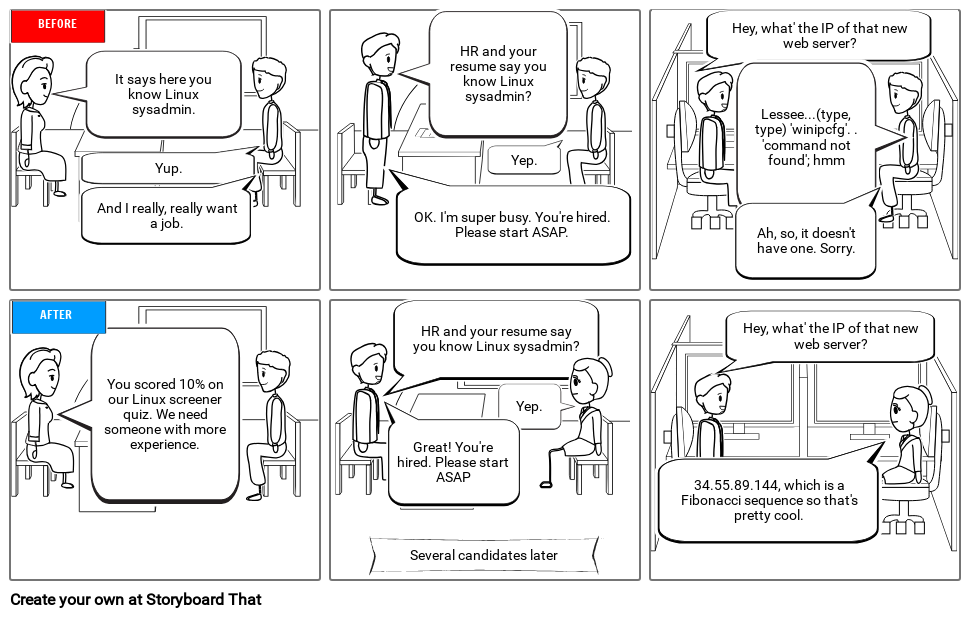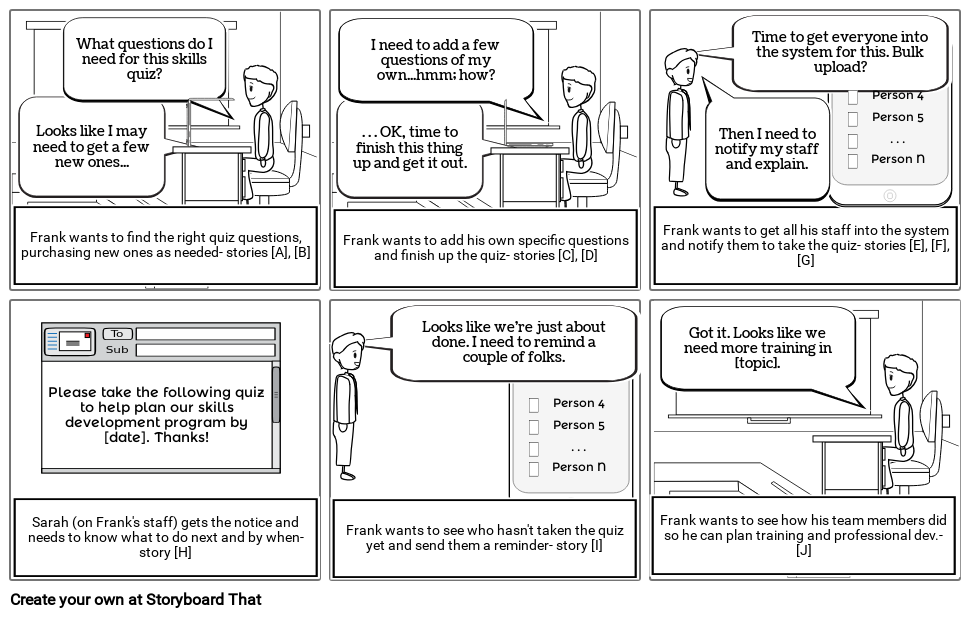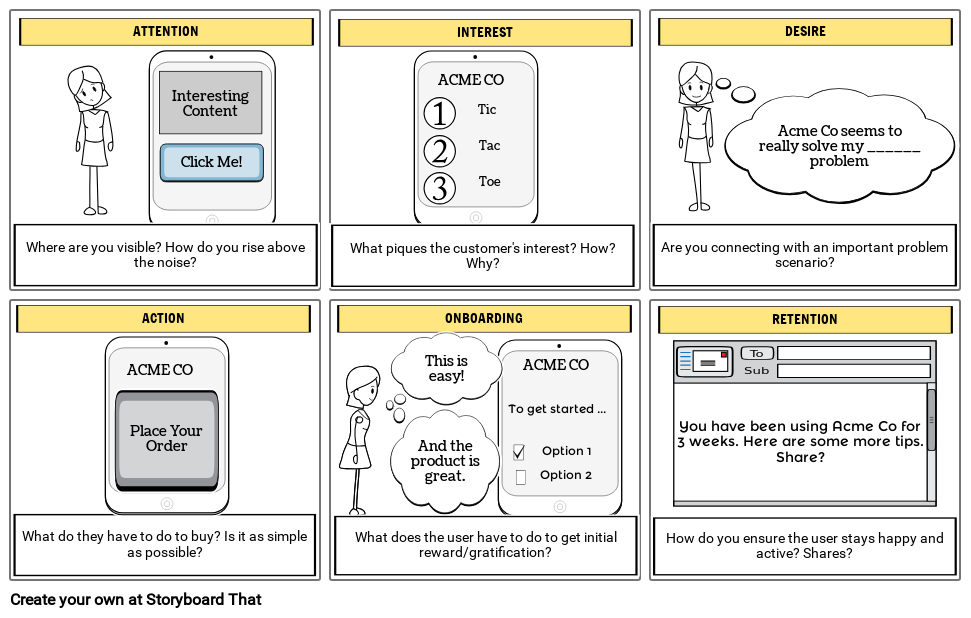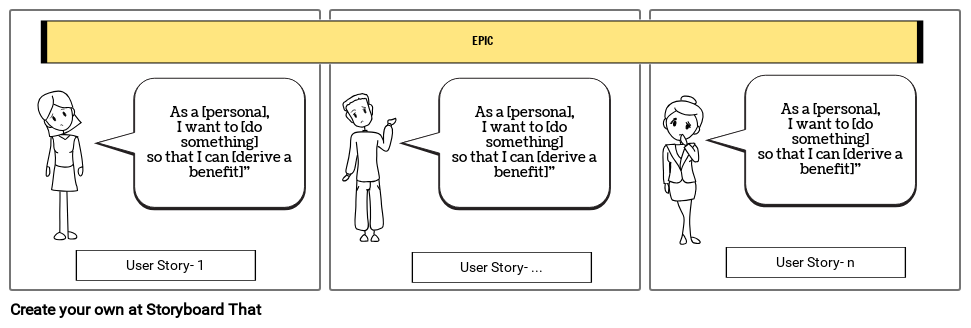Table of Contents
- Storyboards: What? When? Why?
- Storyboards: Tools & Materials
- Thinking Through Your Narrative
- Storyboarding a Product Idea: Before & After
- Storyboard an Epic User Story (Agile)
- Storyboarding the Customer Journey (Growth Hacking)
- Detailing the Customer Journey
- Storyboard Nir Eyal’s Hooked Framework
- Storyboarding & The Venture Design Framework
Innovation that delivers growth. Customer empathy that’s actionable. Killer communication that our audience loves.
We want all these things. Storyboarding is a practice anyone can use to get them. No drawing skills required.
Storyboards: What? When? Why?
While storyboards originated in and remain prevalent with the art & design community, they are ultimately a practical tool. The first documented use of storyboards in their modern form was by the team at Disney working on the ‘3 Little Pigs’ movie. Before that, the animators would work in a room together and just hope that all their hard work was on target and made sense together.

Storyboards are a kind of prototype- something we create to bring our idea to life quickly and cheaply. We use it to vet the idea before we waste time & money on something no one wants. In a relatively literal example, I worked with animator Ed Watkins on the storyboard below. It’s for a video on my site promoting my book. The process of animation is expensive and time consuming, so making sure everyone knows what they want (and why) beforehand is important.

As I mentioned, this is a fairly literal example, but you can use storyboards for just about anything that involves a description of one or more people doing something (even internal actions like thought or emotion). In this tutorial, we’ll walk through the use of storyboards to
- think about new product (or feature) ideas
- narrate key user interactions
- describe the customer acquisition process
- map customer journeys
- analyze the creation of user habits
Storyboards: Tools & Materials
You can create storyboards on the back of a napkin or any old whiteboard, but to help you get started here are two tools to help you color inside the lines:
1. Printed Storyboarding Squares
 STORYBOARDING SQUARES
STORYBOARDING SQUARES
For workshops, group exercises, and generally getting started with storyboarding, I like to use these paper squares and pencil or pen. The PDF you can download here has a set of typical scenes which you can print out and use. They do need to be cut or ripped since there are two/page. You’ll find cutting marks and the individual pages and what I actually like to do is use a metal ruler and just rip them (see left).
2. Storyboardthat.com
I created the squares above with the online tool, StoryboardThat.com and you may find you want to go there and create your own (not to mention creating digital storyboards once you’re ready). If you want to use the above squares in the PDF on Storyboardthat.com, you can copy the storyboard template using the preceding link. Regardless, I highly recommend the ‘pencil’ stencil available on that site for this type of storyboarding.
Thinking Through Your Narrative
Most narratives of this type you can break into these three sections: trigger, action, reward. I highly recommend considering these, particularly if you’re having trouble getting started. Many thanks to Nir Eyal for bringing these key psychological concepts into focus for the practitioner.
| Trigger | How does the problem scenario initiate? |
| Action | How is the action executed? How easy is it? |
| Reward | How is the persona gratified? |
Storyboarding a Product Idea: Before & After
In the practice of design, we try to anchor to ‘problems’. Words are faulty instruments and here ‘problem’ could mean anything from a job to be done (practical/B2B) or a need/desire (consumer). For more on this see the material here on Problem Scenarios.
This framing allows us to describe how we think we’re going to improve the customer/user’s life and answer the pivotal question ‘Is our proposition really better at delivering on this problem than their current alternatives?’. You can use the trigger-action-reward pattern to structure your storyboards on this.
Storyboarding Before and After Scenarios
I use a (fictional) example company called Enable Quiz in my book. They offer lightweight technical quizzes for anyone looking to assess the skill sets of engineers they’re looking to hire. The personas are ‘Helen the HR Manager’, ‘Chris the Candidate’, and ‘Frank the Functional Manager’. Helen’s responsible for doing initial interviews, Chris is being interviewed for the job, and Frank’s the hiring manager (Chris’ hypothetical future boss).
The panels below show a before and after for Enable Quiz’s customers. The alternative is some casual questioning of the candidate (before). Then we think about how this would work with the Enable Quiz solution and its proposition.

Breaking Down Our Story
I like to start the customer discovery process with personas– vivid depictions of your customers in context (think-see-feel-do is a good checklist for describing them). These personas have problem scenarios- needs and desires they’d like to fulfill. They also have current alternatives- things they doing (or not doing) about the problem scenario today. You have a value proposition- something you’re going to offer that you hope is better enough than the current alternatives to win over the customer. 
In our example, Helen the HR Manager’s top problem scenario is that it’s just about impossible for her to assess the technical abilities of candidates who come in for interviews. For Frank the Functional Manager, it’s possible, he has the expertise, but it’s time consuming and awkward. Right now, the alternatives for HR managers are to scan the resumes and maybe call references. For functional managers, it’s to go through an awkward, patchy assessment- or, equally likely, take it on a combination of faith and hope that the candidate has the necessary skills. The ‘Before’ board below describes this situation.
BEFORE
| NOTES | BOARD |
|
Helen the HR Manager does an initial screening on Chris the Candidate. She can look at experience but doesn’t really have the ability to validate the candidate’s skill set. Chris the Candidate is then passed along to Frank the Functional Manager. |
 |
|
Frank the Functional Manager is really busy and just goes and make the hire. |
 |
|
But in this case a stitch in time would have saved nine- the candidate doesn’t actually have the required skills to the degree Frank understood/expected/wanted. Now Frank the Functional Manager has to figure out how to fix a situation where his employee doesn’t have the right skill sets. |
 |
AFTER
The next board narrates the process once the personas of interest have access to the value propositions the Enable Quiz product offers.
| NOTES | BOARD |
|
Helen the HR Manager now has a simple way to screen out candidates missing the skills Frank the Functional Manager has said are an absolute requirement. |
 |
|
Making good hires is rarely easy but Frank the Functional Manager now at least knows they’ll have a certain baseline skill set. |
 |
|
And life’s a lot better. |
 |
Good luck! Please post comments on how this went for you if you have a moment.
Storyboard an Epic User Story (Agile)
If you don’t think through the experience you want customers to have, who will? If you have to make a few guesses along that way, that’s OK. Being right isn’t as important as being explicit and making your ideas testable. Neglect your imaging of the customer experience, and you’re leaving your success to chance.
Agile user stories are a great solution to this problem. Always popular in software engineering, I’m increasingly seeing companies use them for projects in other areas, like marketing. That said, agile stories are not a silver bullet. They encourage good storytelling but don’t guarantee it. Supplementing your major storyboards will help you avoid arbitrary stories, disconnected from (even hypothetical) customer realities.
Tying every major user story back to a vivid, real-world persona & problem scenario and making sure each story has all three clauses is a good checklist for making sure you’re using high quality inputs to drive your product development. Sadly, it’s just a start. Particularly if you’re trying to change a culture of ‘just writing requirements’ or otherwise not substantially engaging with what’s really making users tick, you’ll need to be constantly coaching and showing. You’ll need all the tools you can get.
Quick Review of Agile User Stories
 (Freely skip this section if you know stories up and down.) First off, agile user stories have this format:
(Freely skip this section if you know stories up and down.) First off, agile user stories have this format:
“As a [persona],
I want to [do something]
so that I can [derive a benefit]”
Second, to help stay organized and coherent, stories are often nested within ‘epic stories’. If you’re new to product development, you’ll probably find yourself writing stories that turn out to be epic stories as you get into their particulars. Finally, ‘test cases’ are a good way to layer additional detail against your stories. (see agile user story examples for more).
Storyboard are a great way to humanize and describe epic stories:
Storyboarding an Epic
Let’s take a look at an example epic. I use a (fictional) company called Enable Quiz in a lot of my work. They offer lightweight technical quizzes. Managers use the quizzes to screen new candidates and also assess the skill sets of their existing teams so they can plan training, etc. Let’s say the persona ‘Helen the HR Manager’ wants to use the Enable Quiz service to screen a new engineering candidate. The ‘epic user story’ might be:
‘As the HR manager, I want to create a screening quiz so that I can understand whether I want to send possible recruits to the functional manager.’
The storyboard below summarizes this epic story:  Create a Copy
Create a Copy
I made notes at the bottom of each panel since you’re probably not familiar with the operations of Enable Quiz. If you’re working with a team that’s already familiar with your topic, I wouldn’t worry about that additional level of detail.
Detailing the Epic
In the step above, we wrote an epic and then used a storyboard to thinking through the course and sequence of the epic without necessarily worrying about how the storyboard panels might break down into individual stories. This is the best first step since you want to make sure you’re creating a vivid, credible customer narrative first and then worry about formulating that narrative into stories. Agile user stories are a tool, not a strategy. They provide an opportunity for quality work, but by no means guarantee it.
Now let’s say you’ve got the epic and related storyboard to a place you like (possibly after a few iterations). You want to package up this great epic for discussion with your implementation team and/or colleagues in product. One thing I like to do is take the epic story panels and (once they’re ready) supplement them with notes and individual stories in a simple table. Here’s the epic above broken down (in this example without any further edits):
| NOTES | BOARD |
| This epic assumes Helen the HR Manager and her company have already signed up for the Enable Quiz service to screen job candidates. Helen’s first goal is to set up a quiz to screen candidates for a new engineering position that Frank the Functional Manager has open. The idea with the system is Helen can do more on her own to screen candidates, so she wants to take the initiative and set up this initial screening quiz. This first step makes me think of two child stories that detail the epic: A) “As an HR manager, I want to browse the banks of available quiz questions, matching them with the skill sets described in an open job recruitment so that I can draft a screening quiz with relevant questions.”B) “As an HR manager, I want to check the quiz topics I’ve selected with Frank the Functional Manager so that I can make sure I have the right topics.” |
 |
| Frank is super busy and yet has a very clear idea of what topics are relevant, so the name of the game here is to make it easy for him to answer Helen. This makes me think of the following epic: C) “As a functional manager, I want to review, revise and confirm the set of question topics the HR manager has selected so the quiz will be ready to use for first round candidates.”Note: This raises some interesting and possibly non-obvious questions about how Helen will do this and how we can make it easier for her to collaborate and close on this with Frank. |
 |
| Enable Quiz charges based on the number of question topics (organized in ‘banks’) that the customer wants to use. In our narrative, Helen finds she needs to up her limit on available question banks. I think that suggests this child story: D) “As a manager, I want to increase the limit on how many quiz question ‘banks’ I can use so that I can move ahead with the quiz I’ve formulated.”Note: I’m not adding test cases against these stories in the example, but a good one here would be to make sure that users can put together quizzes with as many question banks as they want, getting warnings about their limit but only encountering a hard requirement to up it once they want to actually use the quiz. Bored with the level of detail here? Well, good products are the accumulation of lots of small, thoughtful details. |
 |
| Now Helen gets an email from Frank- after seeing the draft quiz, he has a couple of his own questions he’d like to add. I think that suggest we have a story like: E) “As a manager, I want to create custom quiz questions so I can add them to my quiz.” |
 |
| We’re ready! Helen’s using the quiz with a candidate for Frank’s open engineering position. That might be a story like: F) “As a manager, I want to administer the quiz to a recruit so I can understand where they are on key skill sets needed for the position.”Note: It’s very likely with a little more digging this story is actually an epic itself and needs more detail, but I’m trying not to bore you, reader, with too much stuff! |
 |
| Helen’s administered the quiz to some recruits and wants to send the results to Frank, possibly with supplemental notes in a few cases. I’d describe that with the following child stories: G) “As an HR manager, I want to send the results of our screening quizzes to the Functional Manager so he can decide who he wants to interview.” H) “As an HR manager, I want to add supplemental notes to results for some of the candidates so I can share additional thoughts on the candidates with the functional manager.” |
 |
Another Examples Epic User Story
Let’s take a look at another example epic. I mentioned that Enable Quiz believes managers will the quizzes to screen new candidates and also assess the skill sets of their existing teams so they can plan training, etc. Let’s say the persona ‘Frank the Functional Manager’ wants to assess one of his teams so he can plan a skills development program. The ‘epic user story’ might be:
‘As a functional manager, I want to administer a skills audit so that I can understand the capabilities of my staff and plan training.’
The storyboard below summarizes a few agile user stories that sit within that epic story:

Create a Copy
Let’s take a look at the child stories this storyboard might suggest. This epic assumes Frank and his company have already successfully onboarded with Enable Quiz, using it for screening new recruits.
| Frank’s first goal is to set up a quiz to complete a skills audit for his team. He has the employees he wants and it’s part of his job to help them make time to develop a holistic skill set. I think this suggests something like the following two stories: A) “As a functional manager, I want to browse the quiz banks [of available questions] so I can make sure I’m subscribed to all the necessary topics for my skills audit.”B) “As a manager, I want to purchase additional quiz banks so I can add additional technical topics to me quizzes.” |
 |
| Frank has some topics specific to their internal products, processes and technologies that he’d like to use for his internal staff. After that, he’s ready to send the quiz. This panels suggests the following two stories: C) “As a manager, I want to create a custom quiz banks so I can add my own questions to the quiz.”D) “As a manager, I want to create a quiz so I can use it with my staff.” |
 |
| Now Frank has to get all his staff into the systems so they can get invitations and their individual results tracked. He might want to do this in bulk and/or on a one by one basis. Child stories that describe this might be: E) “As a manager, I want to create a list of students [employees] from an Excel file so I can invite them to take the quiz.”F) “As a manager I want to create a list of students [employees] online.”G) “As a manager, I want to invite a set of students [employees] to take the quiz so I can see their scores.” |
 |
| Now the employees/students come into play. They need to get a notice that Frank can customize where he communicates what this is about and when he’d like to have them finish the quiz. Suggestions show him how to communicate that the purpose of the quiz is creation of tailored professional development/training vs. micromanagement/big brothering. This might be describe as: H) “As a student, I’d like to understand the objectives and content of the quiz as well as when I need to do it by so I can understand and prioritize it.” |
 |
| People get busy, etc. Frank needs to see who’s finished vs. not so he can send automated and/or human reminders to finish up the quiz. I) “As a manager, I want to see which students have completed the quiz and which have not so I can send them a reminder.” |
 |
| Now he has his result. The objective was to tailor training programs for his team so they’re able to broaden their skill sets in the context of their business schedule. This might be a story like: J) “As a manager, I want to see how the students scored on the test so I can put in place a skills improvement program.” |
 |
Why user storyboards in agile?
Here are a few more reasons I like the user of stories:
- They dovetail with design thinking outputs like personas, problem scenarios and value propositions.
- They are highly consumable by developers, designers, and other creators who are helping you execute, balancing structure and description; specificity and objectives.
- They’re robust and ‘nestable’, scalable even for large, complicated projects.
Storyboards are a great way to keep agile user stories from mimicking the dull, context-free requirements definitions they were meant to replace. They help avoid myopia, making sure you’ve thought through the whole story. They’re also a great way to engage your audience.
Storyboarding the Customer Journey (Growth Hacking)
My favorite framework for thinking about the customer lifecycle is “AIDA” (attention, interest, desire, action). I also like to add an “OR” (onboarding, retention) since these are so important to many of the products I deal with today. Fun fact: this framework is ancient by the standards of today’s business press- it was introduced by marketers in the 19th century (yes, the 1800’s).
AIDA(OR) is one of my favorite storyboarding topics simply because lots of product teams I meet with haven’t thought through the whole acquisition process in vivid, actionable, testable terms. You should absolutely more panels if you feel you have more detail for them but here’s a simple 6-panel reference for an AIDA(OR) storyboard:

Create a Copy
The board below is an example for a fictional company, ‘Enable Quiz’, that I use for example purposes in my book. Enable Quiz offers lightweight technical quizzes for anyone looking to assess the skill sets of engineers they’re looking to hire. The key personas are ‘Helen the HR Manager’ and ‘Frank the Functional Manager’. Helen’s responsible for doing initial interviews, and Frank’s the hiring manager. Here, I’ll narrate a take on the customer acquisition process.
AIDA EXAMPLE (attention, interest, desire, action)
| NOTES | BOARD |
|
ATTENTION: Helen the HR Manager sees a post from her friend (former co-worker) on LinkedIn that she likes something called ‘Enable Quiz’ for screening engineering candidates. |
 |
|
INTEREST: That problem’s on her mind and it catches her notice. The site’s splash page clearly explains what it’s about: effectively, automatically screening technical talent. No assembly required. |
 |
|
DESIRE: Helen’s tired of not being able to improve their success rate on hires and having to clean up the emotional, financial, and logistical mess when a hire doesn’t work out. It’s never going to be 100% but it should be better than it is. Also, Helen has her annual review in three months and she’d love to add ‘implemented new screening system for engineering candidates’ to her list of accomplishments for the year. |
 |
|
ACTION: She checks in with Frank since he has to buy in and give her inputs to tune the quizzes for their positions. Conveniently, the Enable Quiz site has a page for hiring managers that she forwards to him. But he doesn’t read it, she catches him in the hallway, and he says fine, especially if they can try it first and it’s only $2/candidate. |
 |
|
ONBOARDING: She puts in a credit card and they’re rolling with a free trial for 10 candidates. The site’s built-in wizard helps Helen draft quiz content for their open positions and submit it to Frank for review/update. She ends up dragging Frank into her office to finish up but overall the process is pretty painless. They try it out with their first candidate the next day and the results are good. |
 |
|
RETENTION: Screening candidates using Enable Quiz becomes a habit and they’re using on average 20-40 quizzes/month. Helen has herself posted about it on LinkedIn after becoming a fan. They’re thinking about implementing skills audit for their existing staff. |
 |
Detailing the Customer Journey
A great way to extend any storyboard that you see here is to detail out Think-See-Feel-Do for the key personas in each panel.
Storyboard Nir Eyal’s Hooked Framework
COMING SOON
Storyboarding & The Venture Design Framework
Storyboard is a general tool which you can use across just about every part of the Venture Design framework. Personas drive every storyboard. You saw how to bring problem scenarios to life with the before and after storyboard. Storyboarding agile epic user stories is a great way to supercharge your practice of agile. Thinking through user acquisition and the customer journey is a great way to frame your product and promotional executions in vivid, testable terms.

